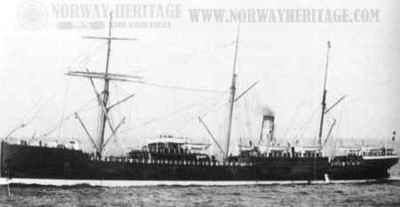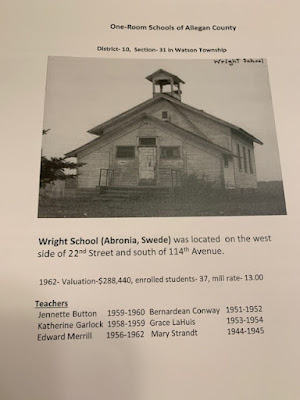This week's prompt is "Travel." I thought I would write about what it was like to travel to America during the 1800's.
Prior to around 1860, our ancestors would have sailed to America on a ship with sails. It would have taken around 4-6 weeks to arrive. They would have been in steerage, which meant they were crammed in with everyone else and had little to no privacy. Cholera and Typhoid were common, not to mention sea sickness. Food and hygiene were bad. It was not a pleasant experience at all. This changed somewhat with the introduction of steam powered ships. Steamships could make the journey across the Atlantic in 2-3 weeks. The living conditions were also a bit better. The first ancestors to come to America on a steamship were Carl and Ulrika Anderson.
Carl and Ulrika left Goteborg, Sweden on a Friday afternoon and arrived in Hull, England on a Sunday afternoon. This was traditionally how sailings went. Leave on a Friday and arrive on Sunday. The journey took around 40-50 hours. They would have needed to be in Goteborg a week before sailing to meet with the ticket agent from the company and go through all the paperwork. They would have needed paperwork from their parish saying where they were leaving from, and where they were heading to. Hull was the major port for arrivals of emigrants traveling to America from northern Europe. After arriving in Hull Carl and Ulrika would have stayed onboard their ship until the train was ready to take them to Liverpool. The train usually left on Monday morning around 11 am and arrived in Liverpool around 3 pm. There were no bathroom facilities onboard the train. At least not for 3rd class passengers. In Liverpool they would stay until they could board the ship taking them to America. I'm not sure how long they would have stayed in Liverpool.
Traveling 3rd class, or "Steerage", was not easy. Passengers would be provided with a place to sleep and food. Passengers had to provide their own mattress and bedding. Also, their own plate, mug, knife, fork, spoon, and water can. They were also advised to make sure they had a good selection of clothes as clothes were more expensive in America. All of these items could be found in Liverpool for sale. Gunpowder was prohibited. Weapons needed to be left with the captain and crew for safe keeping. Valuables were also supposed to be left with the captain or ship's purser.
Food was served by the crew. It probably sounds better than it actually was. Passengers would be served tea and coffee, bread and gruel, soup, beef, pork, fish and potatoes. They were allowed 10-20 cubic feet for luggage.
Passengers were also separated by families, single men, single women. The single men and women would be separated with families in-between them.
After arriving in New York, 1st and 2nd class passengers were allowed to leave the ship. They were seen as more trustworthy. Steerage passengers had to remain on ship until it was time for inspection. They would be given a 6 second once over by a doctor, asked a few questions, and as long as they weren't sick or proclaimed themself an anarchist, they were allowed entry. Anyone could buy a ticket and sail to America to start over.
Carl and Wilhemina Strandt sailed to America in late 1871. They sailed from Hamburg. By the time they arrived in Hull, Hull had built a large waiting room at the train station for the emigrants waiting for the Liverpool train. The waiting room had bathroom facilities, a place to wash up, and a chance to meet with the ticket agents. It was also shelter from the weather. Their passage to America would have been similar to Carl and Ulrika's passage. Crowded conditions in steerage, basic food, and they would have needed to pack their own bedding and cutlery.
When Sven G. H. Johansson "George Henrickson" came to America in 1892, things had improved somewhat. He traveled on the Thingvalla line. His ticket had been bought in America by one of his uncles. The ships in this line were owned and operated by Scandinavians. The crew were all Scandinavian. They promised a quick, low-cost journey to America. The below is taken from the site A Thingvalla Line promotional pamphlet 1887
Is divided into different departments for families, for unmarried males and for unmarried females. Order and cleanliness is provided by crew specially employed for the task. The food is fresh and rich, made of first class food supplies. It is handed out in such rich portions, so it should not be necessary for the passengers to bring any additional food supplies for the voyage to New York The food is served to the passengers by stewards, thus on other steamship lines the passengers usually have to pick up their food at the galley, which of course will be unpleasant in bad weather.
The meals consist of:
Breakfast: Coffee with sugar, bread or biscuits with butter
Dinner: Beef and soup with potatoes and bread. Fish, clipfish with souse and fruit soup, Lobescauce? and Rice soup, varying through the week days.
Evening: Tea with sugar, bread and butter
Everyone gets as much to eat as desired. To the male passengers who desires, it is served every morning one dram of liquor. There are also rich supplies of water. There are bakeries on the ships, where fresh bread is baked every day. The between deck (steerage) is high, light and spacey, and is heated in the cold part of the year. Mothers of infants will receive milk or vrilfood free of charge.
George would have arrived at Ellis Island, where once again as a passenger in steerage, he would have had to wait to pass customs and inspection before being admitted into the country. It normally took around 5 hours.
A couple of final things about Thingvalla lines, they gave out tokens for luggage. When you arrived at your final destination, you exchanged your token for your luggage. Much like a luggage tag on checked suitcases today. Also, they were the only line that promised a direct route to America from Scandinavia. George sailed from Malmo, Sweden to Lubeck, Germany. Then, took the train to Copenhagen and sailed direct to America from Denmark, completely bypassing England.
Ingrid Fahna, George's mother, came to America in 1912. She was able to sail on the Lusitania. She sailed 3rd class, but by that time things had improved immeasurably for 3rd class passengers. She didn't have to supply anything and had much better sleeping and eating conditions. Her ship also sailed the fastest. She crossed the Atlantic in 10 days, whereas others took an average of 2 weeks.
Researching these companies, they reminded me of airlines today. Steerage is now Economy. 2nd Class is Business, and First Class is still First Class. Thingvalla would be the low-cost Spirit or Frontier airlines of today. They all promised to get you to America. The only difference is how much you were willing to pay.
Another thing, many of these companies crammed as many passengers as they could onto their ships. There were complaints about the food, conditions and safety of many of these ships bringing emigrants to America. While researching I found an undercover report that the American government did on a ship. They sent a woman investigator undercover in the late 1800's to see what the conditions were like. She found poor food, poor sanitary conditions, instances of sexual harassment and emigrants being treated more like cattle than human beings. The governments of the United States, England, and others would put regulations and restrictions on the companies. As the undercover report showed though, they weren't always followed.
These are the websites I used to write this blog.
Journey In Steerage from Northern Europe - 1871 | GG Archives
A Thingvalla Line promotional pamphlet 1887
Migration from Northern Europe to America via the Port of Hull, 1848-1914
Questions, comments, additional information? Let me know down below or email me. Please feel free to share and post with others who may be interested.
Image of Hekla steamship that George Henrickson sailed on to America from Copenhagen, Denmark.








